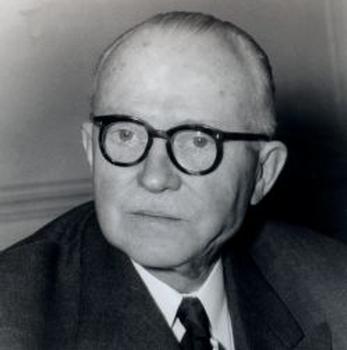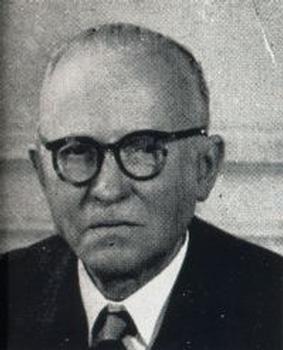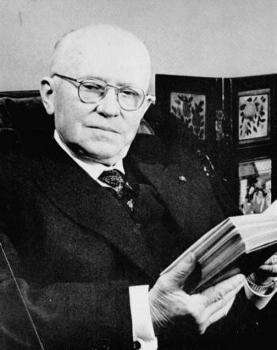French engineer, inventor of prestressed concrete.
Biographical Information
| Name: | Eugène Freyssinet |
|---|---|
| Born on | 13 July 1879 in Objat, Corrèze (19), Nouvelle-Aquitaine, France, Europe |
| Deceased on | 8 June 1962 in Saint-Martin-Vésubie, Alpes-Maritimes (06), Provence-Alpes-Côte d'Azur, France, Europe |
| Place(s) of activity: | |
| Education: | Studies at the Ecole Polytechnique and the Ecole des Ponts et Chaussées |
| 1910 - 1911 | Veurdre Bridge over the Allier |
| 1913 | Boutiron Bridge. |
| 1916 | Eight hangars at Avord, 13 in Istres |
| 1918 | 15 reinforced concrete vessels at Rouen of a length of 55 m. |
| 1921 - 1923 | Aircraft hangars at Orly. |
| Until 1928 | Technical director at Limousin & Cie. |
| 1933 - 1935 | Renovation of the transatlantic pier at Le Havre; first use of prestressing |
| 1941 - 1945 | Several prestressed concrete bridges in France |
Structures and Projects
Participation in the following structures & large-scale projects:
- Annet-sur-Marne Bridge
- Avord Aircraft Hangars
- Berck Lighthouse
- Candelier Bridge
- Caracas-La Guaira Bridge I
- Caracas-La Guaira Bridge II
- Caracas-La Guaira Bridge III
- Changis-sur-Marne Bridge
- Châtel-de-Neuvre Bridge
- Châtillon Maintenance Hangars - Entreprises Limousin
- Compagnie Nationale des Radiateurs Factory Building
- Compagnie Nationale des Radiateurs Factory Building - Entreprises Limousin
- Esbly Bridge
- Fontenay-sous-Bois Maintenance Sheds
- Laon Suspension Bridge
- Orly Airport Overpass No. 10
- Plougastel Bridge
- Pont de Fontaine
- Pont sur le barrage des Portes de Fer
- Prairéal Bridge
- Saint-Michel Bridge
- Station F
- Tonneins Bridge
- Trilbardou Bridge
- Usine de la Compagnie Nationale des Radiateurs
- Ussy Bridge
- Viaduc du Moulin Neuf
Biography from Wikipedia
Eugène Freyssinet (French: [øʒɛn fʁɛsinɛ]) (13 July 1879 – 8 June 1962) was a French structural and civil engineer. He was the major pioneer of prestressed concrete.
Biography
Freyssinet was born in at Objat, Corrèze, France. He worked in the École Nationale des Ponts et Chaussées in Paris, France where he designed several bridges until the First World War intervened. His tutors included Charles Rabut. He served in the French Army from 1904–1907 and again from 1914-1918 as a road engineer.
His most significant early bridge was the three span Pont le Veurdre near Vichy, built in 1911. At the time, the 72.5 metre (238 ft) spans were the longest so far constructed in France although Grafton Bridge a 97.6 metre reinforced concrete bridge had been opened in April 1910 and the Rocky River Bridge in Cleveland Ohio, an 85.34 metre unreinforecd bridge had been opened in October 1910.
Freyssinet's proposal was for three reinforced concrete truss spans, and was significantly less expensive than the standard masonry arch design. The design used jacks to raise and connect the arches, effectively introducing an element of prestress. The bridge also enabled Freyssinet to discover the phenomenon of creep in concrete, whereby the concrete deforms with time when placed under stress. Regarding this bridge, Freyssinet wrote: "I have always loved it more than any other of my bridges, and of all that the War has destroyed, it is the only one whose ruin has caused me real grief".
He served as the director of Public Works in Moulins starting in 1905. He also served as a road engineer in central France from 1907 till 1914.
Eugène achieved a significant breakthrough in thin-shell structures with the design of two huge and celebrated airship hangars at Villeneuve-Orly Airport in 1923. The principle of the corrugated form for the concrete shell was introduced there to obtain necessary stiffness for a 70m span. In 1924 he applied the same principle of corrugated shell roofing for two airplanes hangars spanning 55m at Vélizy – Villacoublay.
Working for Claude Limousin until 1929, he designed a number of structures including a 96.2 m (315 ft) arch bridge at Villeneuve-sur-Lot, and several large thin-shell concrete roofs, including aircraft hangars at Istres, Bouches-du-Rhone in 1917 and 300-foot-wide, 200-foot-high twin dirigible sheds at Orly from 1916 to 1923. During the First World War he also built cargo ships using reinforced concrete at Rouen. Freyssinet's major contribution to the science of concrete construction was the use of forced steam around the concrete moulds which significantly shortened the curing time of the concrete.
His 1919 design at St Pierre du Vauvray again increased the record for a concrete arch span, with 132 m (435 ft) hollow arches, completed in 1923. Also in 1919 his Pont De La Liberation in Villeneuve-sur-Lot was completed which was the largest single span in the world at 96.25 metres.
His largest structure was the Plougastel Bridge with three identical spans of 180 m (592 ft) each, completed in 1930. Here he studied creep in more detail, and developed his ideas of prestressing, taking out a patent in 1928.
Although Freyssinet did much to develop prestressed concrete, he was not ist inventor. Other engineers such as Doehring had patented methods for prestressing as early as 1888, and Freyssinet's mentor Rabut built prestressed concrete corbels. Freyssinet's key contribution was to recognise that only high-strength prestressing wire could counteract the effects of creep and relaxation, and to develop anchorages and other technology which made the system flexible enough to be applied to many different types of structures.
Having left Limousin, he set up his own firm to build prestressed concrete electricity pylons, but the business failed.
In 1935, he used prestressing to consolidate the maritime station of Le Havre which was threatening to settle beyond repair. Freyssinet introduced prestressed concrete beams, and jacked up the shipyard buildings. Following this success, he joined the firm of Campenon-Bernard and went on to design several prestressed bridges.
Many of Freyssinet's designs were new and elaborate for his time—some of them so much so that they were never built, such as the Phare du Monde, a 2,300 foot tower planned for the 1937 World Fair in Paris. According to Leonardo Troyano, "his capacity for creation, invention and research and his non-conformity with existing ideas and doctrines made him one of the most notable engineers in the history of engineering".
Key Achievements or collaborations
- 1906: Pont de Ferrières-sur-Sichon
- 1907: Pont de Prairéal-sur-Besbre
- 1911-1912: Pont du Veurdre,
- 1913: Bridge Boutiron, à Vichy,
- 1910-1919: Pont de Villeneuve-sur-Lot
- 1914-1923: Pont de Châtel-de-Neuvre (demolished in 1940),
- 1922-1930: Pont Albert-Louppe sur l' Elorn entre Plougastel-Daoulas et Brest
- 1922-1923: Pont de Saint-Pierre-du-Vauvray
- 1922: Pont de Tonneins sur la Garonne,
- 1923: Hangars of the Orly Airport
- 1927-1929: the Halle Freyssinet or Halle messengers of the Gare d'Austerlitz in Paris
- 1927-1929: Les Halles "Le Boulingrin" in Reims
- 1926-1928: Factory of the Compagnie nationale des radiateurs de Dammarie-lès-Lys (Seine-et-Marne)
- 1933-1935: renovation of the ferry terminal of Havre
- 1934-1940: Église Saint-Jacques-le-Majeur de Montrouge
- 1936: Aqueduct at Fodda, in Algeria
- 1937-1941: Steel gates on the Barrage at Béni Badhel, Algeria,
- 1938: Bridge on the Autobahn 2 Oelde in Warendorf in Germany, the first prestressed concrete bridge in the country.
- 1941-1946: pont de Luzancy on the Marne (Seine-et-Marne), 54 m span,
- 1946-1951: Orleans Reservoir
- 1947-1950: series of five similar bridges on the Marne (74 m span) to Esbly Ussy-sur-Marne Changis -over Marne Trilbardou and Annet-sur-Marne (Seine-et-Marne)
- 1947 and 1953: runway at Orly airport
- 1948-1951: cut and cover of Rouen,
- 1951-1953: Three overpasses on the highway to Caracas La Guaira, Venezuela
- 1954: Reconstruction and consolidation of the roof of the issuer of l'émetteur d'Europe 1 à Felsberg, Sarre,
- 1955: water pipe sealed Kunu, India
- 1955-1957: Viaduct access pont de Tancarville, the left bank,
- 1955-1958: basilique Saint-Pie X in Lourdes with the architects Pierre Vago and André Le Donne.
- 1955-1961: a multiple-arch dam on the river Erraguene Djen-Djen, Algeria,
- 1957: Bridge No. 10 on the N7 at Orly
- 1957: Pont Saint-Michel à Toulouse,
- 1961-1964: Reservoir des Lilas in Paris
- 1961-1964: Gladesville Bridge, Australia.
Text imported from Wikipedia article "Eugène Freyssinet" and modified on 22 July 2019 under the CC-BY-SA 3.0 license.
Bibliography
- (1936): Aspects nouveaux des problèmes du ciment armé. In: IABSE Publications, v. 4 ( 1936).
- (1951): Conferencia de E. Freyssinet. In: Hormigón pretensado, v. 2, n. 6 (1st Quarter 1951), pp. 1-7.
- (1950): Commission d'études techniques de la Chambre Syndicale des Constructeurs en ciment armé de France . Exposé. In: Travaux, n. 192 (October 1950), pp. 723.
- (1943): Cinquante ans de béton armé: l'évolution future des propriétés des matériaux. In: Travaux, n. 107 (May 1943), pp. 179.
- (1993): Un amour sans limite. Editions du Linteau, Paris (France), pp. 187.
Relevant Websites
Relevant Publications
- (1997): 250 ans de l'Ecole des Ponts en cent portraits. Presses de l'école nationale des Ponts et Chaussées, Paris (France), pp. 222.
- : Architects + Engineers = Structures. Academy Editions, New York (USA), pp. 104.
- (1997): L'architecture moderne en France (Tome 1). 1889-1940. Editions Picard, Paris (France).
- (2005): La arquitectura del ingeniero. 2nd edition, Colegio de Ingenieros de Caminos, Canales y Puertos, Madrid (Spain), ISBN 9788438003176, pp. 499-509.
- (1997): L'art de l'ingénieur. constructeur, entrepeneur, inventeur. Éditions du Centre Georges Pompidou, Paris (France), pp. 194-197.
- About this
data sheet - Person-ID
1000012 - Published on:
29/12/1998 - Last updated on:
31/08/2015












